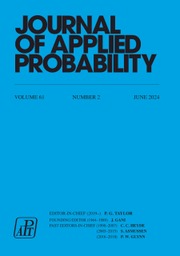No CrossRef data available.
Article contents
Contiguity and remote contiguity of some random graphs
Published online by Cambridge University Press: 19 August 2025
Abstract
Asymptotic properties of random graph sequences, like the occurrence of a giant component or full connectivity in Erdös–Rényi graphs, are usually derived with very specific choices for the defining parameters. The question arises as to what extent those parameter choices may be perturbed without losing the asymptotic property. For two sequences of graph distributions, asymptotic equivalence (convergence in total variation) and contiguity have been considered by Janson (2010) and others; here we use so-called remote contiguity to show that connectivity properties are preserved in more heavily perturbed Erdös–Rényi graphs. The techniques we demonstrate here with random graphs also extend to general asymptotic properties, e.g. in more complex large-graph limits, scaling limits, large-sample limits, etc.
MSC classification
Information
- Type
- Original Article
- Information
- Copyright
- © The Author(s), 2025. Published by Cambridge University Press on behalf of Applied Probability Trust


